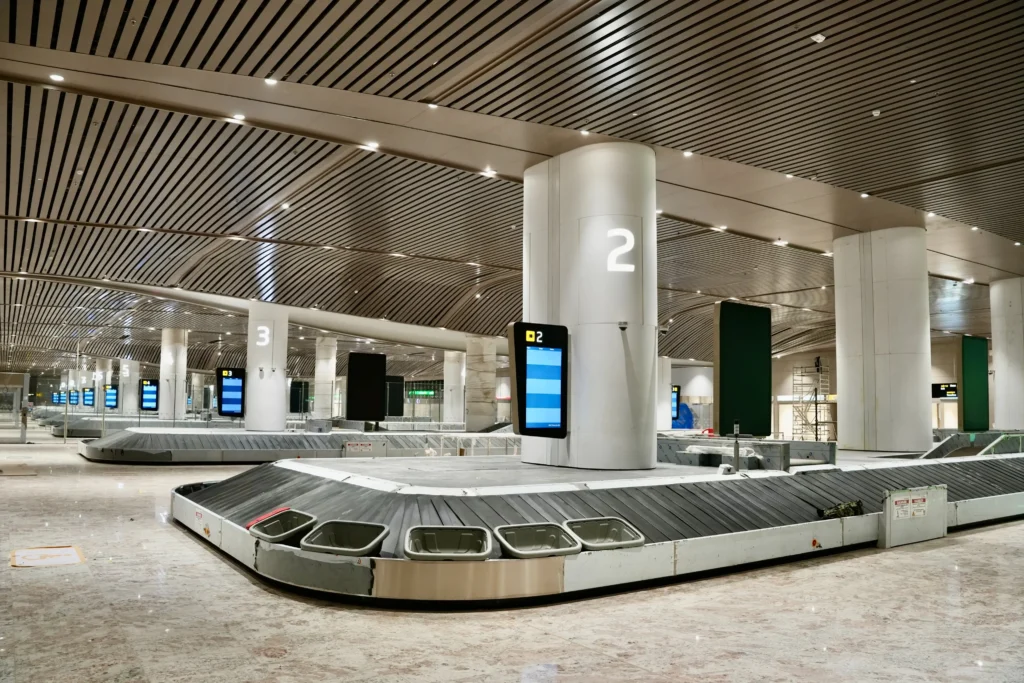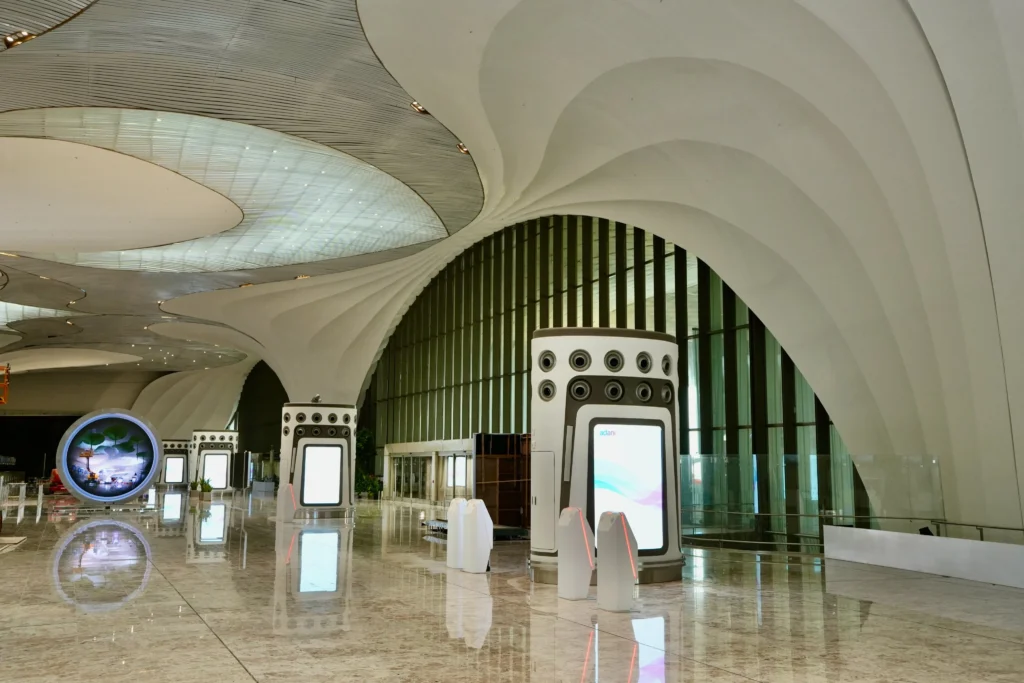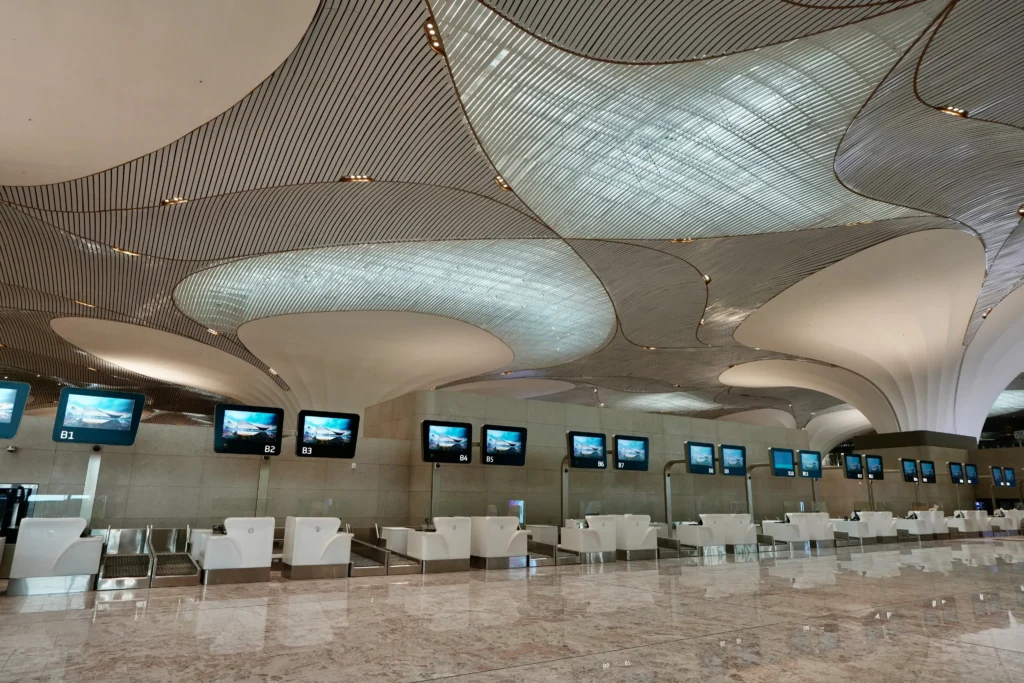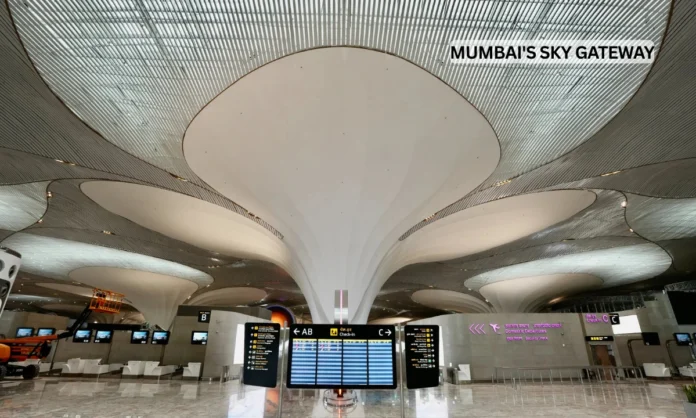Key Highlights:
- Prime Minister Modi inaugurated the first phase of Navi Mumbai International Airport on October 8, 2025, marking a Rs 19,650 crore investment milestone
- The new airport spans 1,160 hectares with initial capacity for 20 million passengers annually, expandable to 90 million passengers upon full completion
- Commercial operations begin in December 2025, featuring India’s first water taxi connectivity and fully digital airport operations
Opening Overview
The Navi Mumbai International Airport officially opened its doors on October 8, 2025, as Prime Minister Narendra Modi inaugurated this monumental Rs 19,650 crore infrastructure project. This greenfield airport represents India’s largest aviation infrastructure development, strategically positioned to transform Mumbai into a global multi-airport city alongside the existing Chhatrapati Shivaji Maharaj International Airport. Located in Ulwe, approximately 37 kilometers from South Mumbai, the Navi Mumbai International Airport addresses the critical congestion challenges facing India’s second-busiest aviation hub.
छत्रपती शिवाजी महाराज यांच्या पावनभूमीत प्रधानसेवक मा. पंतप्रधान नरेंद्र मोदीजी यांचे स्नेहपूर्वक स्वागत!@narendramodi #Maharashtra #ViksitMumbai #NaviMumbaiAirport pic.twitter.com/S0na56ikSm
— Devendra Fadnavis (@Dev_Fadnavis) October 8, 2025
The airport’s inauguration marks a pivotal moment in India’s aviation sector, as Mumbai joins an elite group of global cities operating multiple international airports, similar to New York, London, and Tokyo. With Mumbai’s existing airport handling 55.12 million passengers in FY 2024-25 and operating near capacity constraints, the Navi Mumbai International Airport provides essential relief while positioning the Mumbai Metropolitan Region for unprecedented growth.
Strategic Infrastructure Development
The Navi Mumbai International Airport showcases remarkable engineering and design excellence across its expansive 1,160-hectare footprint. Developed under a Public-Private Partnership model by Navi Mumbai International Airport Limited (NMIAL), the project represents a joint venture between Adani Airport Holdings Limited (74% stake) and Maharashtra’s CIDCO (26% stake).
| Parameter | Navi Mumbai International Airport | Chhatrapati Shivaji Maharaj International Airport |
|---|---|---|
| Total Area (hectares) | 1,160 | 750 |
| Initial Passenger Capacity (million/year) | 20 | 55 |
| Ultimate Passenger Capacity (million/year) | 90 | 65 (post modernization) |
| Number of Runways | 2 (planned) | 2 |
| Terminal Area (sq meters) | 234,000 | 430,000 |
| Cargo Capacity (million tonnes/year) | 3.25 | 1.2 |
| Investment Cost (Rs crores) | 19,650 | N/A (existing) |
| Operational Status | Phase 1 Inaugurated (Oct 2025) | Fully Operational |
The airport’s first phase features a single integrated terminal spanning 234,000 square meters, designed by London-based Zaha Hadid Architects with inspiration drawn from India’s national flower, the lotus. This architectural marvel incorporates 12 sculptural columns symbolizing lotus petals and 17 mega-columns supporting large canopies, creating a distinctly Indian aesthetic while maintaining world-class functionality. The Navi Mumbai International Airport currently operates with one 3,700-meter-long runway designed to Code F specifications, capable of handling the world’s largest commercial aircraft.

Advanced Technology and Sustainability Features
- Digital Innovation: The Navi Mumbai International Airport aims to become India’s first fully digital facility, offering paperless operations, digital boarding passes, and a dedicated mobile application for real-time travel updates
- Automated People Mover: An advanced transit system connects all passenger terminals and city-side infrastructure, ensuring smooth inter-terminal transfers for passengers
Environmental sustainability stands at the forefront of the Navi Mumbai International Airport design philosophy. The facility incorporates solar power generation capacity of approximately 47 MW, dedicated storage for Sustainable Aviation Fuel (SAF), and electric bus services for enhanced connectivity. Most notably, the airport will feature India’s first water taxi service, providing unique multimodal transportation options for passengers traveling to and from the facility.

The airport’s commitment to green aviation extends beyond renewable energy integration. The Navi Mumbai International Airport incorporates advanced waste management systems, rainwater harvesting capabilities, and energy-efficient building designs that align with international environmental standards while supporting India’s climate commitments.
Economic Impact and Industry Transformation
The inauguration of Navi Mumbai International Airport signals a transformative period for India’s aviation sector, which has experienced remarkable growth trajectory as demonstrated in the comprehensive market statistics :infra.
| Year/Period | Passenger Traffic (millions) | Growth Rate (%) | Remarks |
|---|---|---|---|
| 2024 (Total) | 211.0 | 11.1 | India – World’s 5th largest aviation market |
| 2025 (Jan-Aug) | 110.7 | 4.99 | Domestic passenger traffic growth |
| 2024-25 (Mumbai Airport) | 55.1 | N/A | CSMIA annual passengers |
| 2025 Q1 (Mumbai Airport) | 13.6 | N/A | CSMIA quarterly performance |
| 2025 (8 months – Mumbai Intl) | 5.0 | N/A | International arrivals only |
| Projected 2034 (MMR) | 100.0 | Projected | Mumbai Metropolitan Region demand |
Mumbai’s aviation ecosystem particularly benefits from this dual-airport strategy, as the existing Chhatrapati Shivaji Maharaj International Airport recorded over 5 million international arrivals in the first eight months of 2025, maintaining its status as the world’s busiest single-runway airport. The Navi Mumbai International Airport will complement this capacity by initially handling 20-22 flights per hour, with provisions for rapid expansion as operational readiness improves. Leading airlines including IndiGo, Air India, and Akasa Air have confirmed flight operations from the new facility.
Future Expansion and Connectivity Plans
The Navi Mumbai International Airport’s phased development approach ensures sustainable growth aligned with regional demand projections. The comprehensive development timeline demonstrates the strategic planning behind this massive infrastructure project:cidco.
| Phase/Feature | Timeline | Capacity/Details |
|---|---|---|
| Phase 1 Inauguration | October 8, 2025 | 20 million passengers/year |
| Domestic Operations Start | December 2025 | 10-22 flights per hour initially |
| International Operations Start | December 2025 | International routes launch |
| VVIP Terminal Construction | 2026 | Construction begins |
| VVIP Terminal Completion | 2030 | Premium facility operational |
| Full Capacity Achievement | 2032-2035 (estimated) | 90 million passengers/year |
Commercial flight operations are scheduled to commence in December 2025, initially featuring domestic routes with international services following shortly thereafter. The airport will operate with initial flight windows from 8 AM to 8 PM, managing 10 air traffic movements per hour and scaling to 40 movements as operational capabilities expand over six to nine months. The Navi Mumbai International Airport will also feature a dedicated VVIP terminal for high-profile travelers, enhancing Mumbai’s appeal as a destination for international business and diplomatic travel.

Closing Assessment
The successful inauguration of Navi Mumbai International Airport represents more than infrastructure development; it symbolizes India’s aviation industry maturation and Mumbai’s emergence as a true global aviation hub. With its cutting-edge technology, sustainable design principles, and strategic location, the facility positions the Mumbai Metropolitan Region to compete effectively with established international aviation centers.
The airport’s naming after Dinkar Balu Patil honors the legacy of ensuring fair compensation for project-affected communities, demonstrating responsible development practices. As commercial operations begin in December 2025, the Navi Mumbai International Airport will serve as a catalyst for economic growth, job creation, and enhanced connectivity across western India and beyond.
This landmark project establishes a new benchmark for Indian aviation infrastructure while supporting the nation’s aspirations to become a leading global aviation market. The Navi Mumbai International Airport’s success will likely influence future airport developments across India, setting standards for sustainable, technology-driven, and passenger-centric aviation facilities.


